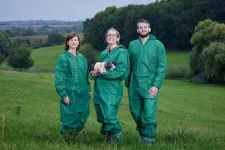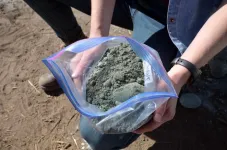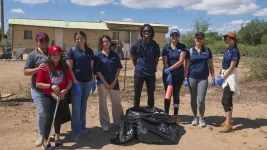(Press-News.org) The NSF-funded FABRIC project has completed installation of a unique network infrastructure connection, called the TeraCore—a ring spanning the continental U.S.—which boasts data transmission speeds of 1.2 Terabits per second (Tbps), or one trillion bits per second. FABRIC previously established preeminence with its cross-continental infrastructure, but the project has now hit another milestone as the only testbed capable of transmitting data at these speeds—the highest being twelve times faster than what was available before. An additional benefit of this infrastructure is to allow FABRIC to federate with other experimental and science facilities at 400Gbps.
“I’m very pleased to learn that the 1.2Tbps TeraCore in FABRIC has been installed and is now operational,” said Deep Medhi, NSF Program Director for FABRIC. “This will provide researchers with unprecedented capability in the FABRIC platform to push data-intensive research that avails the benefit of this capability.”
FABRIC is building a novel network infrastructure geared toward prototyping ideas for the future internet at scale. FABRIC currently has over 800 users on the system performing cutting-edge experiments and at-scale research in the areas of networking, cybersecurity, distributed computing, storage, virtual reality, 5G, machine learning, and science applications. Users now have the capability to test how their experiments run at much higher speeds, including developing endpoints that can source and sink, and protocols that can transfer data at up to 1.2Tbps over continental distances. While previously federated facilities were connected to FABRIC at 100Gbps, with TeraCore becoming operational, the team is also now working to connect several federated facilities at 400Gbps.
“I’m excited for the opportunities that the new 1.2Tbps FABRIC TeraCore ring brings,” said Frank Würthwein, Director of the San Diego Supercomputer Center (SDSC) at UC San Diego. “In the near future, we expect to be able to peer SDSC’s compute and storage capabilities with the TeraCore at 400Gbps by connecting to FABRIC in LA. This will allow FABRIC and Prototype National Research Platform (PNRP) research communities access to unique sets of resources possessed by these platforms, including programmable NICs and FPGAs in both platforms, hundreds of TB of NVMe drive capacity at PNRP, and many others.”
Another reason the TeraCore ring is so instrumental is the fact that much of this research is publicly funded and urgently needed but has been dependent on for-profit companies’ technology. “The advancement to 1.2Tbps brings FABRIC a step closer to making academic research infrastructures more competitive with internet-scale companies,” said Ilya Baldin, FABRIC Project Director. The TeraCore ring opens the door for expanded academic network infrastructure experimentation, thereby accelerating vitally important innovation and discovery. Additionally, this development sets up FABRIC’s infrastructure for future expansion, allowing the possibility to further upgrade portions of the infrastructure as opportunities become available.
The TeraCore ring was built using spectrum from the fiber footprint of ESnet6, the cutting-edge, high-speed network operated by the Energy Sciences Network (ESnet) that connects the tens of thousands of scientific researchers at Department of Energy laboratories, user facilities, and scientific instruments, as well as research and education facilities worldwide.
“The scientific research community needs to be able to share, analyze, and store data as fast and efficiently as possible to solve today’s scientific challenges. Advancements such as FABRIC’s TeraCore ring are a major step in this direction that we’re proud to have helped facilitate,” said ESnet Executive Director Inder Monga.
The FABRIC infrastructure includes the development sites at the Renaissance Computing Institute/UNC-Chapel Hill, University of Kentucky, and Lawrence Berkeley National Laboratory, and the production sites at Clemson University, University of California San Diego, Florida International University, University of Maryland/Mid-Atlantic Crossroad, University of Utah, University of Michigan, University of Massachusetts Amherst/Massachusetts Green High Performance Computing Center, Great Plains Network, National Center for Supercomputing Applications at the University of Illinois Urbana-Champaign, and Texas Advanced Computing Center. FABRIC TeraCore uses optical equipment from Ciena and Infinera and networking equipment from Cisco.
If interested, contact the team at info@fabric-testbed.net to start a conversation around getting your facility connected to the FABRIC infrastructure.
FABRIC is supported in part by a Mid-Scale RI-1 NSF award under Grant No. 1935966, and the core team consists of researchers from the Renaissance Computing Institute (RENCI) at UNC-Chapel Hill, University of Illinois-Urbana Champaign (UIUC), University of Kentucky (UK), Clemson University, Energy Sciences Network (ESnet) at Lawrence Berkeley National Laboratory (Berkeley Lab), and Virnao, LLC.
END
NSF FABRIC project announces groundbreaking high-speed network infrastructure expansion
2023-10-24
ELSE PRESS RELEASES FROM THIS DATE:
More animal welfare or more environmental protection?
2023-10-24
Which sustainability goals do people in Germany find more important: Animal welfare? Or environmental protection? Human health is another one of these competing sustainability goals. A team of researchers from the Department of Agricultural and Food Market Research at the University of Bonn have now found that consumers surveyed in their study would rather pay more for salami with an “antibiotic-free” label than for salami with an “open barn” label that indicates that the product promotes animal welfare. The results have now been published in the journal “Q Open.”
The animal husbandry sector ...
Mass General Brigham names Paul Anderson Chief Academic Officer
2023-10-24
Following a national search, Paul Anderson, MD, PhD, has been named Chief Academic Officer for Mass General Brigham. Anderson, who has been serving in this role on an interim basis since January 1, oversees Mass General Brigham’s world-class research and teaching enterprise, which includes two academic medical centers — Mass General Hospital and Brigham and Women’s Hospital — and three specialty hospitals. Mass General Brigham is the largest hospital system-based research enterprise in the nation, with an annual ...
Biological fingerprints in soil show where diamond-containing ore is buried
2023-10-24
Researchers have identified buried kimberlite, the rocky home of diamonds, by testing the DNA of microbes in the surface soil.
These ‘biological fingerprints’ can reveal what minerals are buried tens of metres below the earth’s surface without having to drill. The researchers believe it is the first use of modern DNA sequencing of microbial communities in the search for buried minerals.
The research published this week in Nature Communications Earth and Environment represents a new tool for mineral exploration, where a full toolbox could save prospectors time and a lot of money, says co-author Bianca Iulianella Phillips, a doctoral candidate at ...
Adding crushed rock to farmland pulls carbon out of the air
2023-10-24
Adding crushed volcanic rock to cropland could play a key role in removing carbon from the air. In a field study, scientists at the University of California, Davis, and Cornell University found the technology stored carbon in the soil even during an extreme drought in California. The study was published in the journal Environmental Research Communications.
Rain captures carbon dioxide from the air as it falls and reacts with volcanic rock to lock up carbon. The process, called rock weathering, can take millions of years ...
Neuroscientist Huda Akil, Ph.D., wins National Medal of Science
2023-10-24
She has explored the brain’s secrets for more than 50 years, delving deep into the genes, proteins and cells that help govern our emotions and moods, and our responses to pleasure and pain.
And today, Huda Akil, Ph.D., received the nation’s highest scientific honor – the National Medal of Science -- for those contributions and their impact on humankind’s understanding of depression, anxiety, addiction and more.
Akil, a neuroscientist at the University of Michigan Medical School and Michigan Neuroscience Institute, and her fellow awardees were honored at the White House in a ceremony ...
AZ-HOPE receives $3.2M HRSA grant to support future health care professionals
2023-10-24
Arizona Health Opportunities Pathways to Excellence, a program of the University of Arizona Health Sciences Office of Equity, Diversity and Inclusion, received a $3.2 million grant from the U.S. Department of Health and Human Services to help students from disadvantaged backgrounds achieve their dreams of becoming health care professionals.
Arizona Health Opportunities Pathways to Excellence, or AZ-HOPE, is a collaboration between academic and community partners to support students’ educational endeavors and help them overcome barriers on the pathway ...
Cleveland Clinic-led trial finds that atrial fibrillation patients undergoing TAVR and Watchman™ procedures together have similar outcomes to using blood thinners after TAVR
2023-10-24
Tuesday, October 24, 2023, Cleveland: Findings from a trial led by Cleveland Clinic show that patients with atrial fibrillation undergoing a transcatheter aortic valve replacement (TAVR) at the same time as a left atrial appendage occlusion (LAAO) procedure using the Watchman™ device had similar outcomes when compared to patients getting TAVR in addition to medical therapy or blood thinners.
Results from the “Safety and Efficacy of Left Atrial Appendage Occlusion at the Time of Transcatheter Aortic Valve Replacement — ...
Upadacitinib in active Crohn’s disease: no added benefit proven due to lack of comparative studies
2023-10-24
Like several immunosuppressive biologics, the JAK inhibitor upadacitinib is also approved for the treatment of Crohn's disease. Commissioned by the Federal Joint Committee (G-BA), the Institute for Quality and Efficiency in Health Care (IQWiG) has now investigated in an early benefit assessment whether the drug offers an added benefit versus the appropriate comparator therapy to patients with moderate to severe active Crohn's disease who have had an inadequate response, lost response or are intolerant to conventional therapy or a biologic agent.
Therefore, an added benefit is not proven due to a lack of suitable study data. The ...
Adapting to climate change: Individuals take action while governments plan
2023-10-24
UNIVERSITY PARK, Pa. — While governments may take the lead in planning and financing climate change adaptation measures, such as incentivizing green infrastructure, individuals currently are most often the ones implementing actions to adapt to climate change, according to new research. The analysis, conducted by an international consortium of researchers from 20 institutions, including Penn State, in 12 countries, published in Nature Climate Change.
“The evidence suggests that individuals and households are the primary adaptation actors — the ones actually implementing ways to ...
New clues to early development of schizophrenia
2023-10-24
Philadelphia, October 24, 2023 – Schizophrenia is a severe neuropsychiatric disease that remains poorly understood and treated. Schizophrenia onset is typically in adolescence or early adulthood, but its underlying causes are thought to involve neurodevelopmental abnormalities. Because human prenatal and postnatal brain tissue is exceedingly difficult to procure and therefore study, researchers have had limited opportunities to identify early disease mechanisms, especially during the critical prenatal period. Now, a pair of studies that appear in Biological Psychiatry, ...




